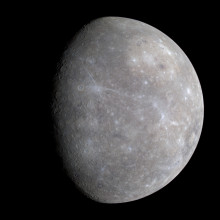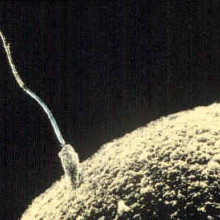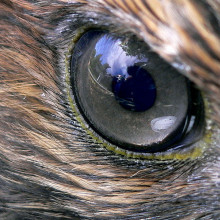In this NewsFlash, we discover the role quartz plays in making mountain ranges, celebrate MESSENGER going successfully into orbit around Mercury, and explore the reasons why birds fly into obvious objects. Plus, how progesterone excites sperm - we explore the role of a sperm-specific protein that could lead the way to a new contraceptive!
In this episode

00:27 - How Quartz Sculpts Continents
How Quartz Sculpts Continents
The mineral quartz might hold the key to why continental plates consistently deform in certain regions, a puzzle that's remained hard to answer despite revolutions in our understanding of plate tectonics.
Publishing in Nature, Anthony Lowry and Marta Pérez-Gussinyé use data from the EarthScope Transportable Array, a programme that is steadily measuring seismic activity across the United States, along with gravity and heat flow data, to estimate the relative proportion of quartz in the crust and look for geographic variation.
 Their research took the relatively novel approach of mapping the ratio between pressure waves (vp) - longitudinal sound waves travelling through the crust, and shear waves (vs) - transverse waves that make the crust move like ripples on a pond. This ratio is not a measure used often in research, as it can be inaccurate and is altered by a number of other factors, such as crust thickness. To iron out these inaccuracies, they combined the ratio values with established data from gravity surveys and estimates of heat flow.
Their research took the relatively novel approach of mapping the ratio between pressure waves (vp) - longitudinal sound waves travelling through the crust, and shear waves (vs) - transverse waves that make the crust move like ripples on a pond. This ratio is not a measure used often in research, as it can be inaccurate and is altered by a number of other factors, such as crust thickness. To iron out these inaccuracies, they combined the ratio values with established data from gravity surveys and estimates of heat flow.
The authors argue that a low vp to vs ratio, less than 1.8, correlates to high concentrations of quartz in the crust, and that as quartz is fragile and prone to flow at the temperatures found at depth, this creates weak zones in the crust. Once these regions of weakness establish a deformation zone, this encourages further weakening processes such as the ingress of water and increased heat flow. This dynamic feedback system would ensure that the crust consistently deforms in regions of high quartz, and could even contribute to a weakening of the mantle layer below the crust, further ensuring a zone of weakness is maintained over many millions of years.
Not only could this model elucidate the role of quartz in making mountain ranges, but it could also help to explain some of the more unusual types of earthquake - those that occur in the middle of continental plates, where there is little or no evidence of the fault lines we associate with the more familiar and better understood earthquakes.
This study only observes an area of the Western United States, but the authors intend to keep monitoring the data as EarthScope moves east, eventually measuring activity across the entire country at 70km intervals. Looking at geologically active regions across the world could give us an even better idea about the role of quartz in sculpting our continents.

03:04 - MESSENGER Orbits Mercury
MESSENGER Orbits Mercury
This week, news that MESSENGER has become the first space probe ever to be placed into orbit around the planet Mercury has been widely reported. This marks a historic milestone in our exploration of the Solar System, thirty years after the Voyager probes returned superb images of its outer planets, Jupiter, Saturn, Uranus and Neptune. Whilst our understanding of the other planets has steadily increased, Mercury has always remained an elusive planet.
 The problem is that it's very difficult to put a spacecraft into orbit about Mercury, because it's so close to the Sun. Any probe sent from Earth has to swoop in towards the Sun, and the effect is rather like rolling down a hill: the probe ends up travelling so fast at the bottom of the hill, when it gets to Mercury, that it shoots past the planet rather than going into orbit.
The problem is that it's very difficult to put a spacecraft into orbit about Mercury, because it's so close to the Sun. Any probe sent from Earth has to swoop in towards the Sun, and the effect is rather like rolling down a hill: the probe ends up travelling so fast at the bottom of the hill, when it gets to Mercury, that it shoots past the planet rather than going into orbit.
The only spacecraft to have made that journey before MESSENGER was Mariner 10 in 1974, which didn't go into orbit and was only able to map one side of the planet as it flew past. MESSENGER has been able to map the other side of the planet, meaning that for the first time, we now have complete maps of the surfaces of all of the planets.
Mercury is fascinating because it's one of the four rocky planets in the Solar System. All four of them appear to have begun from very similar starting points, but to have evolved down very different paths. The Earth, of course, has turned out to be well suited for life. Mars has no magnetic field and a very thin atmosphere, exposing its surface to the Sun's ultraviolet and ionising radiation. Venus' thick atmosphere of CO2 has lead to a runaway greenhouse effect and surface temperatures of 480oC.
Mercury is the twin that we know rather little about. It actually has a fairly strong magnetic field, protecting its surface from the worst of the Sun's radiation, but also suggesting that it has a surprisingly large iron core at its centre. Current thinking is that it might be an Earth-like planet which lost most of its outer mantle in a violent collision with another planet, leaving only the core with a thin outer layer. We will undoubtedly learn much more about Mercury's history over the next few years, and that will help us to understand not only our own Solar System, but also what we might expect to find around other stars.

06:35 - How Progesterone Excites Sperm
How Progesterone Excites Sperm
Dr Steve Publicover, Birmingham University
Ben - Also this week, a pair of papers in the journal Nature have shed some light on how human sperm cells react to the presence of progesterone, and this could lead to a whole new type of contraceptive. Steve Publicover, from the School of Biosciences at the University of Birmingham, penned a "News and Views" article linking the findings of these papers, and explained the implications to me...
Steve - It's been known for more than 20 years now that progesterone, female hormone progesterone - which is produced by the cells that surround the oocyte and they help it to mature and they're still surrounding it after it's been ovulated, so that the egg probably is descending the oviduct, surrounded by a haze of progesterone. So people looked at this ages ago and discovered that progesterone induces a very rapid response in human sperm virtually instantly in as much one can detect. The primary mediator of that seems to be a very sudden rise in intracellular calcium concentration, which is an intracellular message. That was interesting for a number of reasons partly because it clearly had potential significance for fertilisation, and also, because it was not what one we expected steroids, like progesterone, to do. But what we did find out in the meantime was that there is very good reason for thinking progesterone matters in fertilisation. It regulates all sorts of things that we know are really important and at last they've given us a clear precise mechanistic step involved in that whereas up until now, it's been a black box virtually.
 Ben - So the sperm comes into contact with progesterone. What's the next stage? What actually happens?
Ben - So the sperm comes into contact with progesterone. What's the next stage? What actually happens?
Steve - Well what progesterone does is induce an increase in the intracellular concentration of calcium ions which are normally kept in cells very, very low. The cells spend quite a lot of energy mopping calcium up and pumping it out, and keeping it very low. Rises in calcium concentration are used in every cell we know about as a conveyor of information, the size of the rise, and the shape of the rise in terms of its kinetics, things like that. In sperm, certainly, calcium is very, very important for controlling how they swim and controlling a particular secretion event that they do called the acrosome reaction. Progesterone is there as the sperm approach the egg, it may actually be there at very low concentrations in other places as well, but certainly, as the sperm swims right up to the egg, it's going to hit a wall of very high concentrations. It seems to switch on all sorts of things, but progesterone is like a real sort of wake up call. It presses a button, the sperm starts doing things.
Ben - So, the presence of progesterone causes this sudden influx of calcium ions or at least a lack of pumping it out and that obviously is a key stage in changing the behaviour of the sperm cells.
Steve - Yes. We've known that the signal, the changing calcium concentration, was there for ages because there are techniques in measuring concentration in cells which are optical and therefore, they've been quite nice for applying to sperm because the fact that sperm are small and tend to move about a bit, doesn't stop you making the measurements. One of the things that's really key in this, is what's in the Lishko and Kirichok paper, that they developed a technique for applying electrophysiological methods, methods that are used normally in recording the flux of ions across the membranes of nerve cells. They managed to apply it to sperm which are an order of magnitude or so smaller and very, very difficult for various technical reasons to apply these techniques to. They made it work, which meant they could actually measure a flow of ions across the cell membrane. Doing that allowed them to be much more precise to characterise what was going on and to actually identify the fact that progesterone was activating a specific type of protein ion channel in the sperm membrane.
Ben - Does this particular membrane channel have any other role that we're aware of? Is it normally functioning in a very low level and then just gets ramped up by progesterone or is it exclusively for this purpose?
Steve - Up until now, we knew it was there and we knew it was exclusively expressed in sperm. So, the channel is called CatSper because it's a cat-ion channel and it's only expressed in sperm. We knew from various experiments that have also been done on mice that functioning of this channel is very important in regulating the way the sperm swim, and if you produce mice where the gene that codes for this channel has been knocked out, they're still fairly healthy because the only thing that's not going to be working normally is the sperm. The sperm look okay and they can move and they can swim, but they can't undergo a specific change in the way they swim which is called hyperactivation. It's a much more aggressive way of swimming which is switched on as they approach the egg and it seems to be there to provide a kind of added power to get them through the layers that surround the egg in order that they can get right through and do the fusion event. In mice that haven't got this protein, they can't do that change in motility and the result is they're completely sterile.
Ben - So now that we've shed a bit more light on this mechanism, can we start to find ways to use it to our own purposes? Could this be a new contraceptive?
Steve - I think in principle, it certainly could be. It's an enormous opportunity because this is completely specific to sperm and nothing else. If you can produce a drug that hits this channel and nothing else, then you've got a perfect contraceptive. The channel itself belongs to a family which is quite a large one, of voltage operated channels of various sorts, and certainly, some of the other ones are quite similar in their structure. So finding a drug that's really specific to CatSper may turn out to be quite difficult, but I guess in principle, it certainly should be doable. If that could be done, then you could certainly produce a drug that would give you a really nice male contraceptive.
Ben - Steve Publicover from Birmingham University. You can read Steve's news and views article, along with the two papers he discusses, in this week's edition of the journal Nature.

12:39 - Why Birds Crash
Why Birds Crash
Our human eyes may have blinkered us to the way other species see the world, and understanding how birds see could help to reduce the number of fatal collisions with manmade objects such as wind turbines, power cables and even buildings. Now, writing in the journal Ibis, Graham Martin argues that to cut down on deaths, we need to see the world from a bird's perspective.
Sadly, collision with manmade objects seems to account for the largest unintended human cause of avian fatalities worldwide, and many bird species are prone to collisions with structures that appear very conspicuous to us. For example, behavioural observations have shown that White-tailed Sea Eagles in Norway show no tendency to avoid wind turbine blades, simply treating them as if they were invisible.
We know that birds have very good vision - with some species able to pick out fast moving prey from incredible distances, and some species are incredibly dynamic on the wing, able to change direction and speed with apparent ease. So why should objects so obvious to us pose such a problem to birds?
Although some research has looked at collisions from the perspective of flight behaviour & manoeuvrability, very little has been published on the visual and perceptive aspects of this problem. Assuming that the visibility of an object at a distance is the problem, most collision-reducing measures in the last 30 years have involved marking an object with flags or reflective balls; however the probability of collision still remains high.
It's clear that birds don't see the world in the same way as humans - there are distinct differences in eyeball anatomy, location on the head and how the signals are processed in the bird brain. Martin argues that in order to devise effective strategies, we must develop a sensory framework based around a bird's perception of the world.
We are used to the idea of being able to see directly in front of us - usually in the direction we are travelling, but many birds are adapted for coverage alongside, above and behind the head - this may give a wider field of view, but reduces the region of binocular vision in the direction of travel. This lateral vision may play an important role in the detection of predators and foraging, but comes at the expense of being able to see where they're going! Even the Peregrine Falcon, whose vision is good enough to enable them to pick other birds out of the sky, relies mainly on lateral vision - viewing prey from the side and only switching to front-facing, binocular vision at close range.
So what can be done to reduce collisions? There's no catch-all answer, as what works for one species may be invisible to another, but there are some general principles that might help. Large, high contrast markers that employ movement should be deployed around an obstacle, both on the ground nearby as well as directly in front; redirecting flight paths may be more effective than hazard markers, but above all, understanding more about the specific species at risk, and how they see the world, could help to reduce these accidents.










Comments
Add a comment